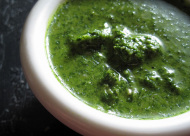Chicken cacciatore
- 12 ingredients
- Servings per recipe: 5
- Serving size: 396 g
Preparation & details:
www.simplyrecipes.com/recipes/chicken_cacciatore_hunter_style_chicken/
Source: Simply Recipes
459 recipes on HappyForks
Amount per 100 g
- Energy (calories): 126 kcal 6%
- Protein: 9.35 g 17%
- Fat: 8.47 g Why gray? Help 17%
- Carbohydrates: 2.43 g 1%
Calorie breakdown
Help
- Protein: 31% 39 kcal
- Fat: 62% 76 kcal
- Carbohydrates: 7% 9 kcal
Omega 6 : Omega 3
Help
1:1 20:1 15:1
General
Energy
126 kcal
6%
Water
78.58 g
3%
Carbohydrates
Carbohydrate
2.43 g
1%
Fiber
0.7 g
3%
Sugars, total
1.3 g
Starch
0 g
Lipids
Total lipid (fat)
8.47 g
17%
Total polyunsaturated
1.689 g
Omega 3 (n-3)
0.101 g
7%
Omega 6 (n-6)
1.551 g
13%
Total monounsaturated
3.901 g
Total saturated
2.211 g
as low as possible
Total trans
0.046 g
as low as possible
Cholesterol
35 mg
as low as possible
Protein + aminoacids
Protein
9.35 g
17%
Tryptophan
0.104 g
33%
Threonine
0.379 g
30%
Isoleucine
0.446 g
37%
Leucine
0.652 g
24%
Lysine
0.725 g
30%
Methionine + Cystine
0.355 g
29%
Methionine
0.235 g
Cystine
0.12 g
Phenylalanine + Tyrosine
0.647 g
31%
Phenylalanine
0.359 g
Tyrosine
0.288 g
Valine
0.455 g
30%
Vitamins
Vitamin C
9.7 mg
13%
Folate, total
10 µg
Folate, DFE
10 µg DFE
3%
Vitamin B-1 (Thiamin)
0.053 mg
5%
Vitamin B-2 (Riboflavin)
0.111 mg
10%
Vitamin B-3 (Niacin)
3.763 mg
27%
Vitamin B-5 (Pantothenic acid)
0.633 mg
13%
Vitamin B-6
0.221 mg
17%
Vitamin B-12 (Cobalamin)
0.15 µg
6%
Vitamin A
295 IU
13%
Vitamin E
0.51 mg
3%
Vitamin D
5 IU
1%
Vitamin K
5.2 µg
6%
Isoflavones, total
0 mg
Minerals
Calcium, Ca
13 mg
1%
Magnesium, Mg
15 mg
5%
Phosphorus, P
88 mg
13%
Iron, Fe
0.68 mg
4%
Potassium, K
207 mg
4%
Sodium, Na
152 mg
10%
Zinc, Zn
0.74 mg
9%
Copper, Cu
0.082 mg
9%
Selenium, Se
7.8 µg
14%
Manganese, Mn
0.08 mg
4%
Similar recipes
Ingredients
| Ingredient description | Matched product |
|---|---|
| One 4 pound chicken, cut into serving pieces, trimmed of excess fat | Chicken · broilers or fryers · meat and skin · raw - 1 chicken, bone removed |
| Salt | Salt · table - 1 tsp |
| 2 Tbsp extra virgin olive oil | Oil · olive · salad or cooking - 2 tbsp |
| 1 medium onion, thinly sliced root to tip, about 1 1/2 cups | Onions · raw - 1 medium (2-1/2" dia) |
| 1 red or green bell pepper, seeded, sliced into 1/4-inch wide slices | Peppers · sweet · green · raw - 1 medium (approx 2-3/4" long, 2-1/2" dia) |
| 8 ounces cremini mushrooms, thickly sliced | Mushrooms · white · raw - 227 g |
| 2 garlic cloves, thinly sliced | Garlic · raw - 2 clove |
| 1/3 cup white or red wine | Alcoholic beverage · wine · table · white - 0.33 cup |
| 2 1/2 to 3 cups peeled and chopped, firm ripe tomatoes, with their juices, or 1 28 ounce can of plum tomatoes in their juice | Tomatoes · red · ripe · raw · year round average - 2.7 cup, chopped or sliced |
| 1/2 teaspoon freshly ground black pepper | Spices · pepper · black - 0.5 tsp, ground |
| 1 teaspoon dry thyme (or 2 teaspoons fresh, chopped) | Spices · thyme · dried - 1 tsp, leaves |
| 1 teaspoon dry oregano (or 2 teaspoons fresh, chopped) | Spices · oregano · dried - 1 tsp, leaves |
Possible differences in nutritional values
All the nutritional values are calculated based on the above products from HappyForks. The precise nutritional values of your recipe may differ due to the use of some specific foods, which not always have a perfect fit in HappyForks. The ingredients used in the recipe may have also different nutritional values than those in our database.
About Nutrition Facts
- Symbol "~" means missing value.
- Percentages next to nutrients show the proportion of daily recommended intake level of nutrients for a healthy person, whose data are included in the nearby profile.
- Nutrition recommendations based on Dietary Reference Intake (DRI) developed by the Institute of Medicine, source.
Advanced mode
- RDA (Recommended Dietary Allowances) - the daily daietary intake level of a nutrient that meet the requirements of 97.5% of healthy individuals in particular age group and gender.
- AI (Adequate Intake) - recommended average daily nutrient intake assumed to be adequate based on approximation of observed mean nutrient intake by a group of healthy people, used when an RDA cannot be determined.
- UL (Tolerable upper intake levels) - the highest level of daily consumption that current data have shown to cause no side effects in humans when used indefinitely without medical supervision.





